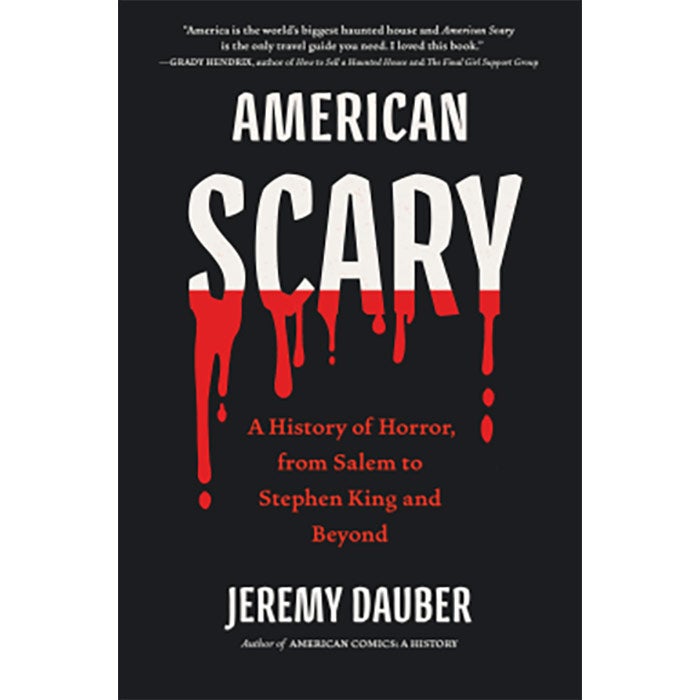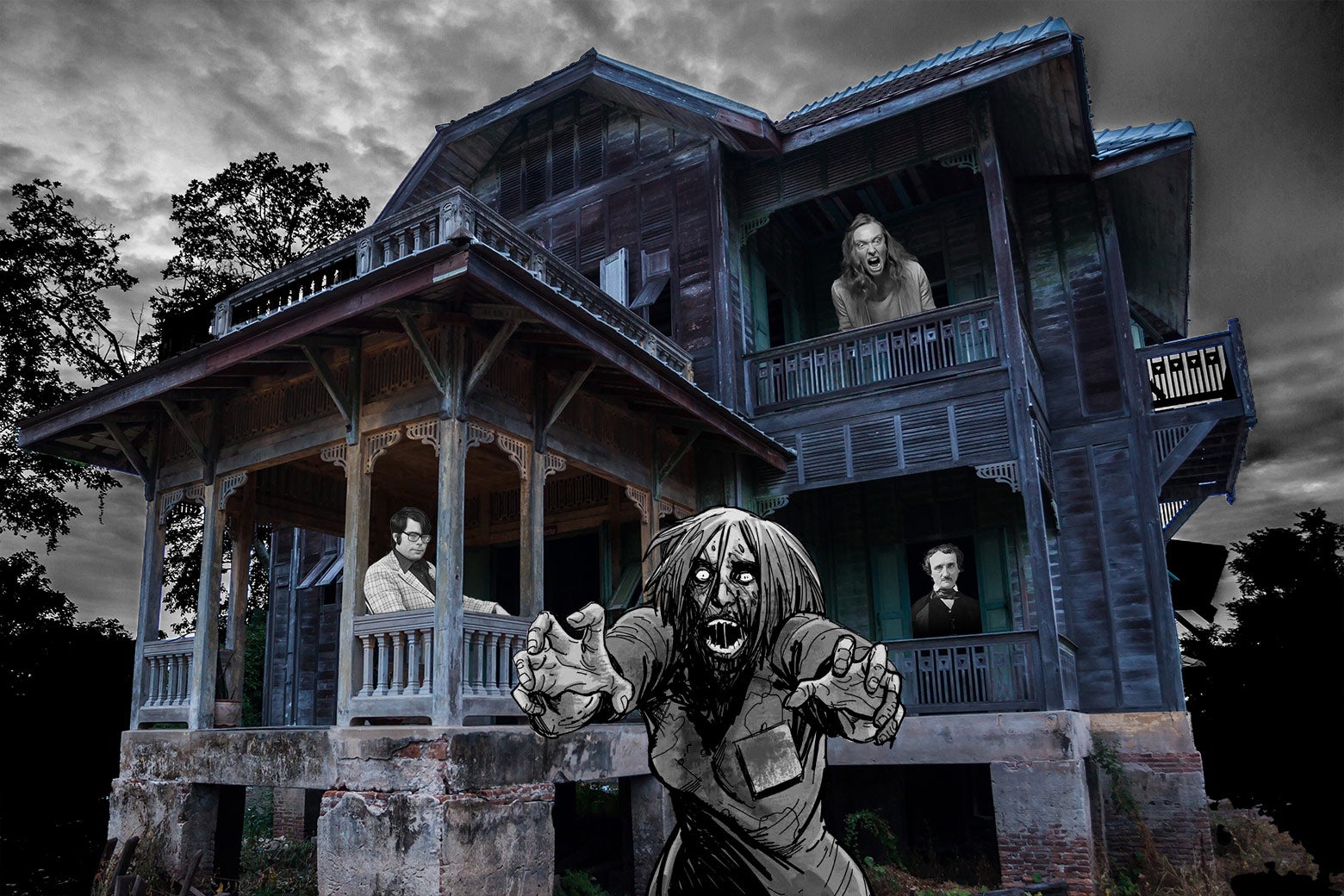The roots of modern horror lie in the British Isles, in Mary Shelley’s Frankenstein and Bram Stoker’s Dracula. But Americans have made the genre their own, and despite the universal, border-crossing fears of death, pain, and decay that horror exploits, it’s American horror that dominates the form now. As Jeremy Dauber’s American Scary: A History of Horror, From Salem to Stephen King and Beyond points out, American writers, dramatists, and filmmakers would seize on Shelley and Stoker’s ideas. But also crucial to the American psyche is a historical trauma, the Salem witch trials, replete with the trappings of fictional scariness, but with an all-too-real human cost. It’s in that nightmare that the real heart of American horror beats.

By Jeremy Dauber. Algonquin Books.
Slate receives a commission when you purchase items using the links on this page.
Thank you for your support.
American Scary is a fannish book, clearly the work of someone who adores the genre and has indefatigably excavated its American roots. Dauber particularly excels at unearthing the work of those now-forgotten writers whose short stories spooked American magazine readers before other forms of popular entertainment came along. It will delight completists who’ll want to seek out the work of authors like Charles Brockden Brown or Alice Cary. But despite appearances, American Scary is less a study than an annotated list, embellished with nuggets of rakishly framed potted history (“LSD had entered the room”) and some pro forma discussions of how various marginalized identities are handled in the genre. (Dauber is a professor at Columbia University.)
Most vexingly, American Horror suffers from Dauber’s reluctance to define “horror” as anything more specific than a story dealing with “fear.” This occasionally leads to intriguing inclusions (I’ll give him the early-American captivity narratives, the purported testimony of white colonists, usually woman, kidnapped by Indigenous people), but it more often leads to frustrating digressions. Discussions of Lolita, Lenny Bruce, Pulp Fiction, and The Bonfire of the Vanities don’t seem to me to shed much light on the horror genre.
Dauber’s right, though, to identify Salem as a keystone to American horror, an event that illustrates how intertwined the genre is with history. This isn’t unique to American horror; the earliest Gothic novels, set in moldering castles and decommissioned abbeys, were themselves haunted by the bloody memory of the Reformation and the violently suppressed Catholicism in England’s past. Convents and monasteries are the Native American burial grounds of the British Gothic. In America, however, the past is closer. The historian Mary Beth Norton has argued that the witch trials were rooted in trauma and anxiety about the wars with the Indigenous people raging on the borders of the colonies. The trials’ recurring image of a “black man” lurking in the woods seeking to corrupt the settlement’s Puritan residents into devil worship supports that thesis.
The bad conscience of the colonizers that comes back to haunt their descendants is racialized, although Dauber has to look harder for examples of horror fiction that taps into the legacy of slavery. Perhaps that’s because the Native people who made those burial grounds are gone (although, of course, not really), while the descendants of the enslaved are part of everyday American society, with more pressing and guilt-inducing demands than spectral vengeance. But while fear of the continent’s vast wilderness and the strange people fighting to keep their hold on it might have animated the witch hunt, the actual horrors were perpetrated by the colonists on one another.
American horror places a singular and ambivalent emphasis on the conflicting perils of community and solitude. Edgar Allan Poe, one of America’s most influential early writers, is nevertheless rarely thought of as being notably American. That’s partly because many of his stories have unidentified or vaguely European settings. It may also be because he is the loneliest American writer, down to his forlorn death from still-unknown causes after collapsing in a Baltimore tavern. Poe’s main characters tend to be isolated and brooding, mourning dead maidens, holed up in decrepit mansions. Sometimes, the one person with whom they have any connection is the antagonist on whom they’re perpetrating demented revenge.
For Poe’s contemporary, Nathaniel Hawthorne, by contrast, the wilderness offered characters like Hester Prynne and her daughter, Pearl, a place to live authentically, in a state of nature, away from the unjust constraints of Puritan society. This individualistic fantasy of getting away from it all, of being unfettered by the corrupting demands and restrictions of community, still runs strong through American culture. Like Huck Finn, we long to escape our messes by lighting out for the territory. Poe was a stranger to this dream. His characters get stuck, rot, and go mad. Or worse. Poe’s literary heir, H.P. Lovecraft, once wrote a story, “The Outsider,” whose narrator struggles mightily to get out of the dismal castle where he has lived alone for as long as he can remember. When he finally does, the humans he meets flee from him, screaming, and then he looks into a mirror to see a hideous monster.
Hiding in your garret might be your downfall, but so might making a life in a friendly small town where every year your fellow citizens pick a neighbor to stone to death, as they do in Shirley Jackson’s notorious story, “The Lottery.” On the other hand, in the late 20th century, horror storytellers in many media became obsessed with serial killers, a rare threat but one that actually existed, which made them much scarier than witches or vampires. The serial killer seemed a product of a particularly American form of rootless anonymity, a menace spawned in a world of drifters, hitchhikers, and strangers who picked their victims seemingly at random and were therefore difficult to identify and catch.
Hiding in your garret might be your downfall, but so might making a life in a friendly small town where every year your fellow citizens pick a neighbor to stone to death.
Even the most recent forms of popular horror exploit this tension between the dangers of being together and the hazards of remaining alone. The zombie story is a tale of civilization gone rotten—of lifeless, mindless mobs who threaten to devour the handful of survivors who retain their souls. Zombie movies and series like The Walking Dead are retooled Westerns that take place in a frontierlike setting from which the social order as we know it has been wiped away. The small band of the living must team up to rebuild society, a task that always involves plenty of exasperating conflict and power struggles and quarrels about how things ought to be run. Meanwhile, their settlements are in constant threat from savage hordes who can be slaughtered without remorse, the way Westerns in the bad old days used to dispatch Native Americans.
One reason why Stephen King’s fiction, for all its nightmares, rarely feels as bleak as Poe’s or many contemporary horror films is that King doesn’t idealize individualism or regard community as an irksome necessity for survival. Often it’s friendship—particularly among children, but also among his often working-class heroes—that gives his characters the strength to fight off supernatural evil. King characters are most vulnerable when, as with Jack Torrance, such unwholesome practices as alcoholism, fanaticism, and writing lead them to cut themselves off from and abuse others. In director Ari Aster’s folk-horror film Midsommar, on the other hand, a seemingly lovely village turns out to be sustained by human sacrifice. The flip side of the friend groups that sustain King’s characters are the weird sects that, as in Hereditary, drive Aster’s characters to grisly rituals. The American dread of the solitary serial killer is only rivaled by our fear of cults composed of people whose loneliness leaves them susceptible to the worst form of community.
Both of these anxieties have merit. One reason why the problem of togetherness has tormented American horror for centuries is that it can’t really be resolved. It’s just that in America, we allow ourselves to fantasize that we can escape it—that we can attain self-sufficiency, elude collective responsibility, erase the legacy of the past, and remake our world to form a more perfect union. How many haunted house movies begin with some wholesome nuclear family moving into their dream home, where they expect to finally, at last, be happy? Horror fiction is around to say: not so fast. The one thing you can’t ever get away from is yourself. And that’s where the monsters come from.

